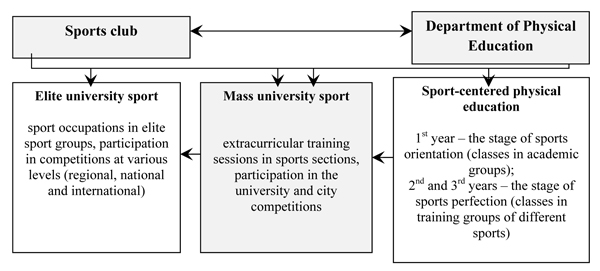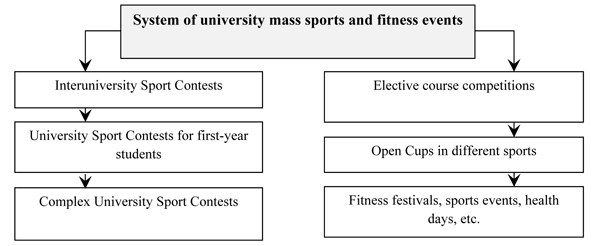Sportization of Physical Education as a Condition of Development of Student Sport in Non-Sports Universities
Фотографии:
ˑ:
N.V. Peshkova, associate professor, Ph.D.
L.I. Lubysheva, professor, Dr.Hab.
A.A. Peshkov, associate professor, Ph.D.
Surgut state university, Surgut
Key words: university sport, sportization of physical education of students, formation of personality sports culture.
Introduction. Nowadays much attention is being paid to the development of university sport in our country. It is caused not only by arising new tasks of higher school physical education intended to promote sports culture, the values of healthy way of life in the youth environment and considering university sport as a key condition of formation of reserve for elite sport [3].
Hence, when planning the development of university sport one is to take into account that, like modern sport in general, it can be divided into mass and elite sport with relevant goals and objectives.
The purpose of the study was to validate the relevance of sportization of physical education of students as a condition of development of mass university sport in non-sports universities.
Results and discussion. Sport-centered physical education has been established in the practice of many Russian comprehensive schools. This technology is widespread in Omsk, Surgut, Naberezhnye Chelny, Tchaikovsky where experts have accumulated a considerable amount of experimental data, that indicate the significantly higher efficiency of sports-centered physical education of pupils compared to the present traditional system. Thanks to sportization one can not only improve physical fitness and health of children, but it also contributes to the familiarizing of younger generation to the values of sport culture, enhances their level of education and competence in the field of sport as well as sports lifestyle formation [4].
Despite all the good of results obtained during the sportization, it is not used widely enough in universities. The issue was pointed out in the works of M.V. Bazilevich, A. V. Kozlov, A.N. Legotkin, S.V. Radaeva, et al., but the integral system of university sports education hasn’t yet been developed.
It is to be clarified what we consider as an integral system. If we turn to the works of L.I. Lubysheva [1], dedicated to sportization in a comprehensive school, we can see that the author proposes to implement such innovations as sports-centered physical education, school sports club, sports culture as a discipline, “Sports team in every school”. All of these projects can be put into practice separately and their effectiveness is confirmed by many authors: N.M. Akhtemzyanova, O.S. Zdanowich, L.N. Progonyuk, V.A. Romanovich, D.V. Fonarev, E.A. Fonareva et al.
We believe that the integral system of sports education of young people can be created only when all these innovations, adapted to the university conditions, will complement each other and create an environment in which every student will be involved in university sports regardless of the initial level of training and experience of participating in various competitions in one way or another.
The department of physical education is responsible for the implementation of sports-centered physical education (Fig. 1). We consider expedient the following form of its organization. The first stage corresponds to the first year of education and it is appropriate to define it as a stage of sports orientation after L.I. Lubysheva. The main objectives faced by teachers of the department of physical education concerning the development of mass university sport are: firstly, to help a student choose a particular kind of sport he will be involved in during further education; secondly, to create the motivation for the additional extracurricular sport classes in sport sections; thirdly, to introduce a first-year student to the system of sports and fitness events, held in the university, and to choose a suitable form of participation (as a participant, judge, volunteer or active fan).

Fig. 1. Organization of mass university sport.
The next stage corresponds to the 2nd and 3rd years of education - the stage of sports perfection, where various types of training in the chosen sport are implemented. It is important that competitive activity is an integral part of this process (Fig. 2).

Fig. 2. The system of university mass sports and fitness events.
It is competitions what helps young people to objectively assess their own capabilities and to compare their achievements. Competitive activity and its results are strong incentives for further work at self-improvement, which involves such qualities as perseverance and persistence, the ability to improve oneself and to achieve goals.
As shown in Fig. 1, the principal role in the development of university sports belongs to the university sports club, whose organizational and functional structure has been presented earlier [2]. Sports Club ensures the necessary level of quality, efficiency, accessibility and attractiveness of extra sports occupations for students (this issue is especially important for senior students) and it also provides the organization of mass sports and fitness activities. Sports Club unites student-athletes, forms university teams that further protect the university honor in competitions of various levels. The achievements of teams and individual athletes are a common pride for university, the athletes are paid tribute to like heroes at festivities and they become role models for those who choose the path of self-perfection.
Hence, the innovations being realized within sportization of physical education ensure such a university environment where a student becomes a participant of the sports movement from the first year of studies, which facilitates the formation of the positive attitude to sport and regular sports occupations.
In conclusion it can be marked that scientists keep seeking the ways of the optimal planning of the system of development of university sport and introducing youth in active sports occupations, where the core aspect is to form the sports culture of students’ personality provoked by developed sports values.
References
- Lubysheva, L.I. Sportization at comprehensive school / Ed. by L.I. Lubysheva. – Moscow: Teoriya i praktika fizicheskoy kultury i sporta, 2009. – 168 P. (In Russian)
- Peshkova, N.V. Planning of the system of control of development of student sport in modern university / N.V. Peshkova, A.A. Peshkov // Teoriya i praktika fizicheskoy kultury. – 2012. – № 5. – P. 83-85. (In Russian)
- Peshkova, N.V. New in the system of control of development of student sport in Surgut state university / N.V. Peshkova, L.I. Lubysheva, A.A. Peshkov, V.V. Apokin. – 2012. – № 11. – P. 85-87. (In Russian)
- Physical culture and sport in the Russian Federation: new challenges of modern times: monograph / S.V. Alekseev [et al.]. – Moscow: Teoriya i praktika fizicheskoy kultury i sporta, 2013. – 780 P. (In Russian)
Author’s contacts: peshkova_ffk@mail.ru




